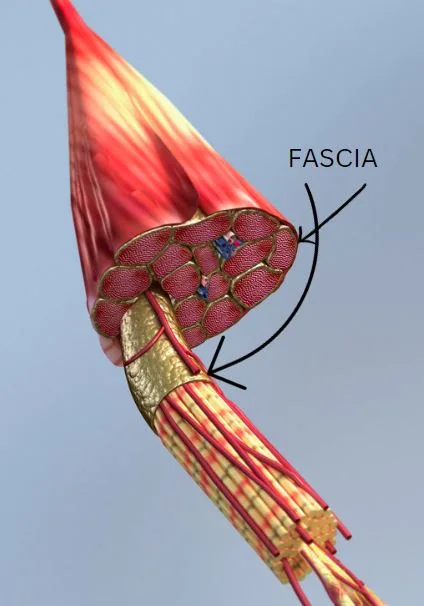Myofascial release is a manual therapy technique often used in therapeutic massage as well as physiotherapy or physical therapy. It focuses on relieving muscle tension and stiffness through the manipulation of the ‘myofascial’ tissues – the tough membranes that wrap, connect and support your muscles.
The technique has gained widespread recognition “emerging as a strategy with a solid evidence base and tremendous potential” due to its effectiveness in dealing with various physical conditions and improving overall well-being. The purpose and benefits of myofascial release will shed light on why it’s increasingly adopted in modern therapeutic practices.

What Is Myofascial Release Therapy?
Myofascial release is a therapeutic technique that helps to alleviate pain and treat myofascial pain syndrome. It does this by targeting the fascia – the connective tissue that surrounds muscles and organs. This type of therapy involves applying gentle pressure to specific points in the body to release tightness and tension within the fascia. Essentially, myofascial release works by breaking up adhesions and knots in the fascia, which can restrict movement and cause pain.
By releasing these areas, the body is able to move more freely and comfortably. Myofascial release can be used to help treat a variety of conditions, including chronic pain, injuries, and even headaches. It’s a non-invasive, safe, and effective way to help improve your overall health and well-being.
Benefits Of Myofascial Release

Relieves Pain and Tension
One of the most significant benefits of myofascial release is its ability to relieve pain and tension in the body. When the fascia becomes tight and restricted, it can cause various pain and discomfort in different parts of the body.
Myofascial release helps to release these restrictions and relieve the pressure, reducing pain and tightness. It is an effective technique for anyone who suffers from chronic pain or tension in their body.
Improves Athletic Performance
If you are an athlete or someone who enjoys working out, myofascial release can help you improve your performance. When the fascia is tight and restricted, it can limit your range of motion, making it harder to perform certain movements.
Myofascial release helps to release the tension in the fascia, improving your flexibility and range of motion. It can also prevent injuries and decrease recovery time after exercise.
Enhances Relaxation
Myofascial release is a relaxing therapy that can help you reduce stress and anxiety. The gentle pressure applied during the therapy can induce a state of deep relaxation, allowing your body and mind to unwind. The relaxation can promote better sleep and improve your overall mood and well-being.
Used By Certified Massage Therapists
At Pampered Spirit in Point Pleasant, NJ, professional certified massage therapists have a lot to say about integrating myofascial release therapy with massage techniques.
This therapeutic technique involves applying gentle, sustained pressure to the connective tissue surrounding the muscles, resulting in increased range of motion, decreased pain, and improved circulation.

Myofascial release is an ideal complement to therapeutic massage and can be especially beneficial for clients with chronic pain or sports injuries. With a focus on holistic wellness and relaxation, Pampered Spirit’s clean and serene spa environment provides the perfect backdrop for experiencing the rejuvenating effects of myofascial release.
What Is Myofascial Pain Syndrome?
Myofascial pain syndrome is a condition that can be incredibly difficult to manage. It can be characterized by persistent pain throughout the body, often in the muscles and connective tissues. This pain can be incredibly debilitating and can lead to a whole host of other issues, such as fatigue, difficulty sleeping, and even depression.
Unfortunately, myofascial pain syndrome is often misdiagnosed or overlooked completely, leaving many sufferers feeling helpless and frustrated. While there is no cure for this condition, there are many treatment options available that can help alleviate symptoms and improve quality of life. It’s important to work with your doctor to find the right treatment plan for you, which may include a combination of medication, physical therapy, and self-care techniques.
Myofascial Trigger Point Therapy Vs. Massage Therapy
Whether you’re looking to reduce muscle soreness, improve flexibility, or simply relax, there are many different therapies to choose from. Two popular options are myofascial trigger point therapy and massage therapy. While both techniques focus on the muscles, they differ in their approach. Myofascial trigger point therapy targets specific “trigger points” in the muscle that can cause pain and dysfunction, while massage therapy uses broader strokes and kneading to promote relaxation and circulation.
Ultimately, which option you choose will depend on your individual needs and preferences. Do you prefer targeted pressure to address specific issues, or a more general approach to overall relaxation? Whatever your preference, both myofascial trigger point therapy and massage therapy can be effective tools for promoting wellness and reducing stress.

How To Locate Myofascial Trigger Points
If you’ve ever had a muscle knot that just won’t go away, you may have a myofascial trigger point. These points are painful, tight spots in the muscle tissue that can cause discomfort and limit movement.
The tricky thing about them is that they can sometimes be difficult to locate. However, there are a few ways to track them down. One method is to press down on the muscle with your fingers and search for areas that are tender or sore.
Another technique is to use a foam roller or massage ball to roll over the muscle and pinpoint where the tightness is most prominent. If you’re not sure where to start, it may be helpful to consult with a physical therapist or massage therapist who can guide you in locating these trigger points. Once you’ve found them, you can begin targeting them with specific exercises and stretches to relieve the tension and alleviate the pain.
Can Myofascial Release Help Chronic Pain Disorder?
Chronic pain disorder is a debilitating condition that can significantly affect the daily life of those who suffer from it. While there are various treatment options available, many individuals seek a non-invasive and drug-free approach to alleviate their symptoms. This is where myofascial release comes in. This therapeutic technique involves applying gentle pressure to the connective tissues of the body, known as fascia, to release tension and restore mobility.
Research has shown that myofascial release can be an effective treatment for chronic pain disorders, helping people manage their symptoms and improve their overall quality of life. By targeting the root cause of the pain, myofascial release can provide long-lasting relief, making it an approach worth considering for those seeking a natural solution to their chronic pain.
myofascial release is a powerful therapeutic technique
It targets the connective tissues of the body, providing relief from chronic pain and improving mobility. Its effectiveness extends to treating various conditions, including myofascial pain syndrome, and assisting in the management of chronic pain disorders. While the process of locating myofascial trigger points can be a challenge, professional guidance or self-help tools like foam rollers can assist in this endeavor.
Above all, understanding the key role of fascia in our body can lead to a greater appreciation for this therapy. Whether used in conjunction with other treatment methods or as a standalone therapy, myofascial release offers a promising avenue in the realm of holistic wellness and pain management.
